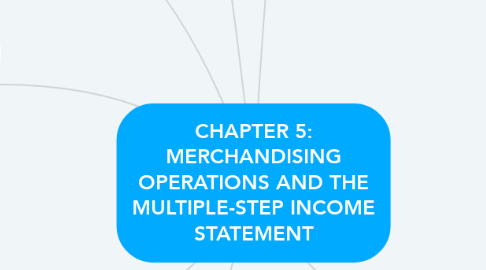
1. Single-step vs Multiple-step income statement
1.1. Single-step
1.1.1. Net income = Total Revenues - Total Expenses
1.2. Cost of goods purchased = Purchases - Purchase Return - Purchase Discounts + Freight-in
1.3. Multiple-step
1.3.1. Gross profit = Net sales - Cost of Good Sold
1.3.2. Income from operation = Gross profit - operating expenses
1.3.3. Net income = Income from operation +/- other activities
2. Cost of good sold (periodic)
2.1. Cost of goods sold = Beginning Inventory + Cost of goods purchased - Ending Inventory
3. Factors affecting profitability
3.1. Gross profit rate = Gross profit / Net sales
3.1.1. higher ratio => the average margin between selling price & inventory cost is increasing
3.1.2. too high a margin may result in lost sales
3.1.3. higher value => favorable return on each doller of sales
3.2. Profit margin ratio = Net income / Net sales
4. Quality of earnings indicator
4.1. Quality of earnings ratio = Net Cash provided by Operating Activities / Net Income
4.1.1. <1 => using more aggressive accounting techniques
4.1.2. >1 using conservative accounting techniques
5. Sales Revenues (perpetual)
5.1. Two entries for each sale
5.1.1. Selling price
5.1.1.1. increase (debit) Accounts Receivable or Cash
5.1.1.2. increase (credit) Sales account
5.1.2. Cost
5.1.2.1. Decrease Merchandise Inventory
5.1.2.2. Increase Cost of goods sold
5.2. Sales Returns and Allowances
5.2.1. To record credit granted to Sauk Stereo for returned goods
5.2.1.1. increase (debit) Sales Returns and Allowances
5.2.1.2. decrease (credit) Accounts Receivable
5.2.2. Normal Balance: debit
5.3. To record cost of goods returned
5.3.1. increase (debit) Merchandise Inventory
5.3.2. decrease (credit) Cost of Goods Sold
5.4. Sales Discounts
5.4.1. Accounts Receivable = Cash + Sales Discounts
5.4.2. Net sales = Sales - Sales Returns & Allowances - Sales Discounts
5.4.3. Normal Balance: debit
6. Service Company vs Merchandising Company
6.1. Income Measurement
6.1.1. Net income = Gross profit - Operating Expenses
6.2. Operating Cycles
6.2.1. Service Company
6.2.2. Merchandising Company
6.3. Flow of costs
6.3.1. Perpetual System
6.3.1.1. Maintain detailed records of the cost of each inventory purchase and sale.
6.3.1.2. Records continuously show inventory that should be on hand
6.3.2. Gross Profit = Sales revenue - Cost of goods sold
6.3.3. Periodic System
6.3.3.1. Company determines cost of goods sold each time a sale occurs
6.3.3.2. Physical inventory count to determine cost of goods on hand
6.3.3.3. Do not keep detailed records of the goods on hand.
6.3.3.4. Determine cost of goods sold only at end of accounting period
6.3.4. Additional Considerations (perpetual)
6.3.4.1. Traditionally used for merchandise with high unit values.
6.3.4.2. Provides better control over inventories
6.3.4.3. Requires additional clerical work and additional cost to maintain inventory records.
7. Purchases (perpetual)
7.1. Purchase invoice
7.1.1. Invoice date
7.1.2. Seller
7.1.3. Purchaser
7.1.4. Salesperson
7.1.5. Credit terms
7.1.6. Freight terms
7.1.7. Goods sold: Catalog number, description, quantity, price per unit
7.1.8. Total invoice amount
7.2. Freight costs
7.2.1. Seller
7.2.1.1. FOB Destination
7.2.1.2. Operating Expense
7.2.2. Buyer
7.2.2.1. FOB Shipping point
7.2.2.2. Merchandise Inventory
7.3. Purchase Returns and Allowances
7.3.1. Return
7.3.1.1. debiting Accounts Payable
7.3.1.2. crediting Merchandise Inventory
7.3.2. Allowance
7.3.2.1. debiting Accounts payable
7.3.2.2. credting Cash
7.3.2.3. crediting Merchandise Inventory
7.4. Purchase discounts
7.4.1. 2/10, n/30
7.4.2. 1/10 EOM
